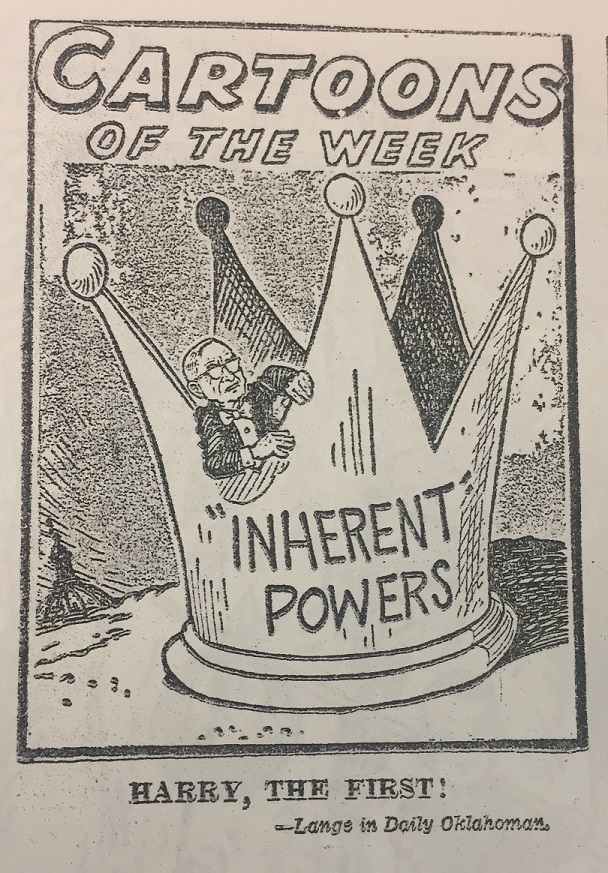
Background
From 1950-1953, the United States was involved in the Korean War. To fund the war, Truman originally wanted to increase taxes and implement credit controls to limit inflation. Many Americans were opposed to this due to the previous two decades of shortages from the Great Depression and World War II rationing, so the government was forced to get creative in thinking of other ways to fund and mobilize for war. The Office of Price Stabilization (OPS) enacted price controls on various wartime industries, including steel tonnage pricing, while the Wage Stabilization Board (WSB) worked to limit wage increases for workers to what they felt was a reasonable amount. With these two major agencies, the US was able to keep producing war materials without interruption from labor and industry disputes over prices and wages.
As time went on, slight changes had to be made to the wartime economy. Taxes ultimately had to be increased over time, but wages were increasing too slowly to please many of the labor groups in the US. This situation especially upset the steel unions. The steel industry was vital to the war effort, and the steel unions were strong. They wanted to capitalize on their importance to the defense efforts by granting wage increases to steel workers. By late 1951 the unions were asking for wage increases above the 10% maximum set by the Wage Stabilization Board. The companies told the unions that they would not allow these wage increases unless they could guarantee a higher sale price for the steel they were producing. After several round of negotiations, the Office of Price Stabilization still did not agree to the tonnage hike the steel companies wanted, so the companies denied the wage increases demanded by the unions. The unions threatened to strike, and a domestic crisis began. Truman immediately threw his support behind the union workers, as they were some of his biggest political supporters. However, he found himself in a precarious political situation.
The threat of a strike continued throughout early 1952. In March, the WSB recommended the steelworkers be granted a wage increase. Worrying that their profit margins would drop if they paid their workers more money, the steel companies asked the OPS for an increase in steel tonnage pricing. The OPS refused the proposed price increase and made a lower counteroffer, angering the steel companies. In the midst of these arguments, the workers decided to strike. With important supplies for the war effort hanging in the balance, Truman had to determine what to do.
It is within the president's power to put people back to work through strikes, but there are different ways to go about it. For instance, in 1917 President Wilson nationalized the railroad industry to keep workers from striking during WWI. Truman could do something similar via Executive Order, but he had other options as well. In 1947 Congress passed the Taft-Hartley Act, which banned strategies to help workers organize unions and limited the president's power to seize industries during times of labor unrest. Instead, it offered the president the power to force workers back to work for 80 days while negotiations continued between labor and management. This option would keep wartime industries running uninterrupted. In 1948, an amendment was added to the Selective Service Act, allowing the president to seize industry facilities that were unable to fill their government orders for wartime products. The steel industry was not defaulting on its order obligations; however, as commander-in-chief, the president can make all military decisions for the United States, including mobilization efforts.
In the end, Truman issued Executive Order 10340 to seize control of the steel industries on April 8, 1952. The companies sued, resulting in a Supreme Court case to determine whether or not Truman overstepped his Constitutional powers in the steel seizures.
Key Question
Did Truman overstep his Constitutional powers in seizing the steel industries in 1952?
Materials
Documents to be examined:
- Radio and Television Address to the American People on the Need for Government Opreation of the Steel Mills, April 8, 1952
- Letter from Harold Enarson to the President, May 8, 1952
- Political Cartoon “We’re Waiting to Hear from the Principal,” May 24, 1952
- Telegram from George Fehlman to the President, April 9, 1952
- The Constitutional Issues in the Steel Case, April 26, 1952
- Letter from Harry Truman to Supreme Court Justice William O’Douglas, July 9, 1952
- Executive Order 10340, Directing the Secretary of Commerce to Take Possession of and Operate the Plants and Facilities of Certain Steel Companies, April 8, 1952